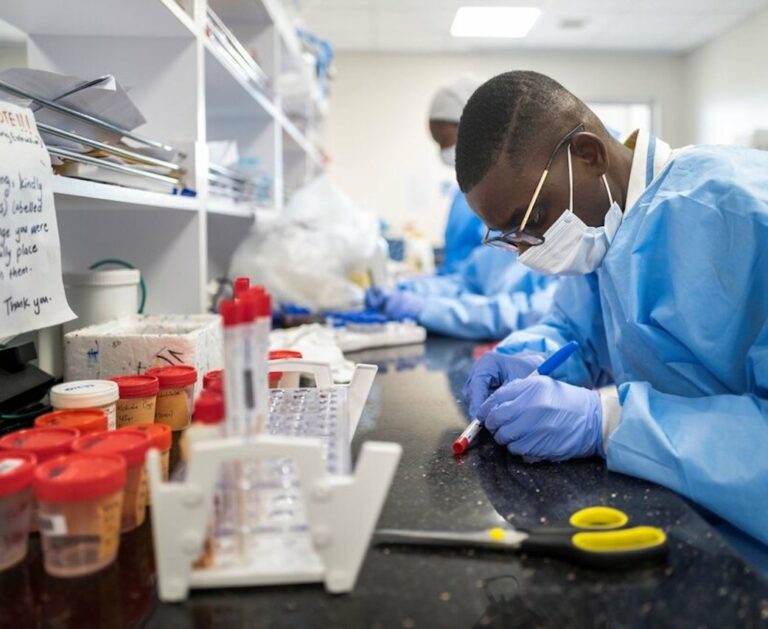South Africa Covid-19 mRNA Vaccine Technology Transfer Hub (mRNA hub)
- Founded
- June 2021
- Governance
- World Health Organization (WHO), Medicines Patent Pool (MPP) and the South African Consortium (Afrigen, Biovac and the South African Medical Research Council), with support of Africa Centres for Disease Control and Prevention (Africa CDC) and the South African National Department of Science and Innovation.
- Funding
- Indicative view: the 5-year budget is 92 million euro; currently more than half of this amount has been raised (approximately 52 million euro).
- Description
The South Africa mRNA Vaccine Technology Transfer Hub (also referred to as mRNA hub or WHO hub) is set up as result of Workstream III of the COVAX Manufacturing Task Force. The initial objective of the programme is to set up permanent Covid-19 mRNA vaccine production capacity in low- and middle-income countries, resulting in enhanced accessibility of these vaccines and increased levels of self-determination. The WHO recently stated that the mRNA hub can also be used to expand manufacturing capacity for other products needed for health priorities. They are currently identifying the needs in the region to see what diseases they will focus on in the future.
The concept functions as a hub-and-spoke model: hubs (technology transfer centres) transfer a comprehensive technology package, including training, to spokes (commercially sustainable manufacturers). The South African hub is based at Afrigen Biologics & Vaccines. This company with manufacturing facilities is developing a robust mRNA vaccine research and development (R&D) and production process based on information available in the public domain. The technology will later be transferred free of charge to spokes. On their turn, spokes will use the received technology to produce vaccines and distribute them among low- and middle-income countries.
The WHO has the (global) lead, coordinates and monitors, while the MPP will assist with intellectual property matters. At least 40 countries have expressed their interest in receiving the developed technology. To accommodate them, more hubs and spokes must be identified worldwide. Thus far, the WHO announced that fifteen manufacturers (the spokes) will receive technology through the mRNA hub. They are located in Egypt, Kenya, Nigeria, Senegal, South Africa, Tunisia, Indonesia, Brazil, Argentina, Pakistan, India, Vietnam, Bangladesh, Serbia and Ukraine. Training of the first spokes started in March 2022. Commercialization of vaccines powered by the South African hub is expected to take place at the end of 2024.

Strengths
- Structural solution.
- Opportunities for long-lasting impact for self-determination of low- and middle-income countries, because the production facilities will not be controlled by high-income countries nor foreign companies.
- Opportunities for long-lasting impact for low- and middle-income countries’ self-sufficiency.
- Economically sustainable as the concept can also be used to develop mRNA vaccines for other diseases (such as cancer, zika, tuberculosis and HIV).
- Helps utilizing existing local production capacity.
- The hubs and spokes can act on the whole spectrum of the vaccine pipeline (e.g. research, development, production), enhancing efficiency and safety.
- Also serviceable with regards to sharing of other data than the mRNA technology (e.g. information on other vaccine techniques).
- Technology transfer from right holders is not required per se (but without such transfer, the development process will be delayed).
Weaknesses
- More funding is needed to continue expanding the reach and impact of the mRNA hub, both in terms of diversifying the vaccines manufactured for various diseases, and increasing the number of spokes.
- It may take time before the South African mRNA vaccine will be available, as it is expected to take between 24 and 36 months.
- Right holders refuse to cooperate, which slows down the development process (but also leaves control over the vaccine with the mRNA hub, which is an advantage).
Review
The establishment of the mRNA vaccine technology transfer hubs is a great asset to build capacity, increase sovereignty and work towards better global access to mRNA vaccines and potentially for other medical technologies too. The hub-and-spoke model seeks on the one hand to bring regions with insufficient production capacity the means to manufacture mRNA vaccines themselves. On the other hand, the model aims to distribute the locally produced vaccines locally too. Though, to which extent this is guaranteed is unclear at this point.
The intention is that the programme accomplishes a permanent higher level of self-reliance and independence for low- and middle-income countries. These advantages can have a lasting nature, as the facilities may in the future be utilized to produce vaccines against other diseases too.
The success of the concept depends on a set of preconditions. For starters, more funding is needed to support the mRNA hub and spokes in South Africa and the other, to be established hubs and spokes. Secondly, it is crucial that there are no intellectual property barriers in the countries concerned that can hinder the vaccine production, or that those rights are made available to the hub. Also, to achieve health equity goals it is important that the products resulting from the work of the hubs and spokes, are indeed supplied to people and regions most in need.
Lastly, with the pandemic raging on, inequality growing and unnecessary deaths continuing, time is of the essence. Beware, the hub can achieve success faster if right holders (Moderna and/or Pfizer) contribute to the process by sharing necessary information. On the other hand, when Moderna and Pfizer refused to collaborate, the mRNA hub went ahead to develop its own formula to produce the Afrigen mRNA hub vaccine. As a result, it will have control over the vaccine including pricing and the distribution criteria.